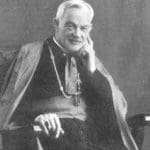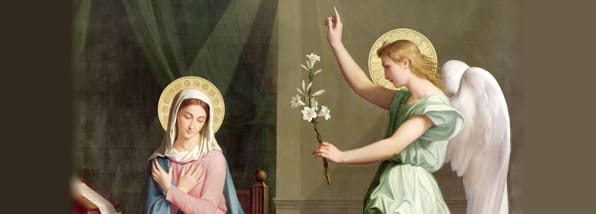THE FIAT OF MARY
“And Mary said, Behold the handmaid of the Lord, be it done to me according to thy word. And the Angel departed from her.” Luke 1:38
 1. The Angel had spoken three times. First he had showed the deepest reverence for Mary; and to this she had answered nothing, but, disturbed in mind, had pondered much and waited. Then he had announced to her the great message with which he had been entrusted; and to this Mary had replied by quietly asking “How?” Lastly, he had explained the work of the Blessed Trinity in her. In a special way she understood; she who, as seen from many infallible signs, was steeped in the Scriptures; she who, by the special grace of God, and by her own incomparable innocence of soul, was endowed with special clearness of vision; she who, by exercise in the school of prayer, possessed in the fullest degree that “spiritual understanding” so much prized by St. Paul. Mary was the first to hear and to grasp the great revelation of the New Gospel; the mystery of the Blessed Trinity, and the Incarnation.
1. The Angel had spoken three times. First he had showed the deepest reverence for Mary; and to this she had answered nothing, but, disturbed in mind, had pondered much and waited. Then he had announced to her the great message with which he had been entrusted; and to this Mary had replied by quietly asking “How?” Lastly, he had explained the work of the Blessed Trinity in her. In a special way she understood; she who, as seen from many infallible signs, was steeped in the Scriptures; she who, by the special grace of God, and by her own incomparable innocence of soul, was endowed with special clearness of vision; she who, by exercise in the school of prayer, possessed in the fullest degree that “spiritual understanding” so much prized by St. Paul. Mary was the first to hear and to grasp the great revelation of the New Gospel; the mystery of the Blessed Trinity, and the Incarnation.
2. Her answer is prompt and decisive. There is no hesitation, such as even a saint might have made. Each word is full of meaning. Her readiness and joy in making herself the instrument of the designs of God are shown by the first word “Behold!” Her profound humility reveals itself in the term by which she speaks of herself “The handmaid of the Lord.” This word also conveys her reason for consenting. Great as was the honour, wonderful the grace, glorious the station on earth and in heaven to which she was invited, she accepted them for no other reason than because such was the will of God her Lord and Master. The words “Be it done unto me” show her marvelous faith. For the Angel had not said she was to do this or that; but that she was to be in a manner passive, though willingly so, in the execution of the great mystery. And the last expression, “according to Thy Word,” shows her faith and humility, as also her joy that the accomplishment of the work was to be brought about in the manner which increased instead of diminishing or impairing the glory of her chastity.
3. This “Fiat“ of Mary is more than her own word. It is the conclusion and fulfillment of all her own longings, and of all the longings of all the holy souls that had preceded her since the days of Eve. “Let it be done, Let it be done,” had been the prayer of all the ages, and at last the word had been said which was the “Amen” of the litany. She speaks in the name of all the world, in the name of all creation; for her “Fiat” is the acceptance for them of that union with God for which, as St. Paul says, all creation yearns. She stands between heaven and earth, linking the two together, the channel through which God chooses to pass from His throne to the cottages of men, the Mother of divine grace, the Cause of our joy, and all because she had the simplicity, and therefore the unconscious courage, to accept the call of Him who loved her: “Behold the handmaid of the Lord, be it done to me according to Thy Word.”
Summary Mediation Points:
1. Mary understood in a special way the significance of the mysteries declared to her by the Angel.
2. Each word in her answer reveals secrets of her heart and soul.
3. Her “Fiat” is the fulfillment of the longings of all time, of all creation; the acceptance of her station as Queen of all saints.
 Editor’s Note: This meditation is from Archbishop Alban Goodier’s “The Prince of Peace” (1913).
Editor’s Note: This meditation is from Archbishop Alban Goodier’s “The Prince of Peace” (1913).
Art: The Annunciation, Auguste Pichon, 1859, Restored Traditions, used with permission. Archbishop Alban Goodier, S.J., www.stmaryscadoganstreet.co.uk, all rights reserved, used with permission.





